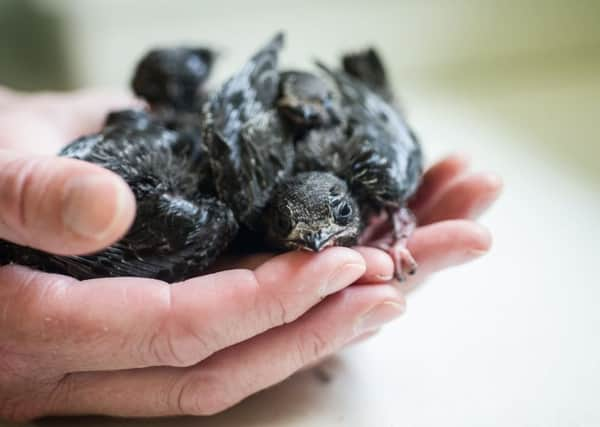Flood of patients swamps wildlife '˜Noah's Ark'


The Scottish SPCA’s purpose-built facility near Alloa in Clackmannanshire was intended to cater for 3,000 to 5,000 creatures annually. But a record 9,359 wild animals come through its doors last year, and early figures suggest even more will be admitted in 2017.
The latest patients to arrive at the National Wildlife Rescue Centre in Fishcross are a trio of newly hatched swift chicks, which were discovered on a pavement in Fife earlier this week. They are the youngest ever swiftlets to be treated at the centre and will need round-the-clock care for the next few weeks including hand-feeding every few hours with mini meatballs made from mince and dried insects.
Advertisement
Hide AdAdvertisement
Hide AdEach year the Scottish SPCA rescues wildlife of every kind, from red squirrels to otters, pine martens, weasels and stoats. The swiftlets are among nearly 1,000 casualties currently being tended at the premises, including 45 tawny owls, 10 barn owls, 150 gull chicks, 200 mallard ducklings, six swan cygnets, eight roe deer fawns, 10 harbour seal pups, two grey seals, 60 hedgehogs and 356 garden birds.
The Scottish SPCA is the only national animal welfare charity that rescues birds, and these make up three-quarters of all patients at Fishcross.
Centre manager Colin Seddon has 13 permanent members of staff, plus extra seasonal workers during periods of high demand. “Since we opened our new National Wildlife Rescue Centre in 2012 we’ve treated almost 35,000 wildlife casualties, which is considerably more than we expected,” he said.
“Our centre at Fishcross has allowed us to expand the number of wild animals we can care for by including on-site veterinary facilities, seal, swan and otter pools, aviaries, wild mammal enclosures, paddocks and a stable block for deer.
“Our National Wildlife Centre has become one of the largest and busiest centres in the UK, with new rehabilitation techniques and diets being developed on site and adopted by other centres.
Notable success stories include a sea eagle from Mull, which had fractured a leg and a wing and was not expected to survive. Dubbed a “medical miracle”, it was released back into the wild.
Another involves a rare snowy owl found in Caithness late last year – one half of what was believed to be the UK’s only nesting pair. It broke a wing after being hit by a train. The team at Fishcross were able to repair the damage and nurse it back to health so it could be freed at the same site.
But if demand for such treatment continues to rise the charity will need to raise extra money to extend its operation. “We could expand, we’ve got the room, but it’s a cost thing,” said Seddon. “It’s not just about building enclosures, we also need the right staff to operate. Working with wild animals is quite specialised and can be risky so we can’t really use volunteers.”
Tomorrow marks the start of Scottish SPCA’s National Wildlife Week, which celebrates the charity’s endeavours.